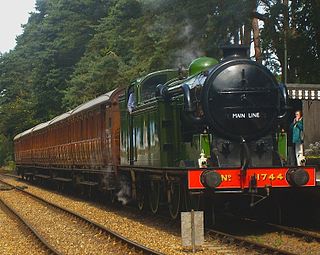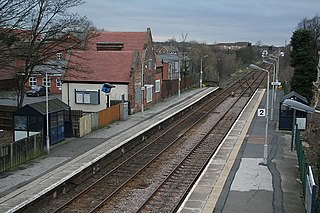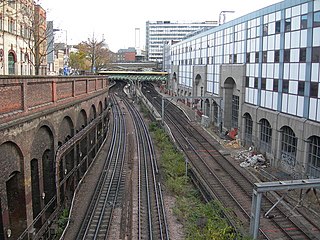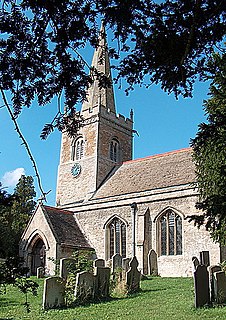
The North Norfolk Railway (NNR) – also known as the "Poppy Line" – is a 5+1⁄4-mile (8.4 km) heritage steam railway in Norfolk, England, running between the towns of Sheringham and Holt. The North Norfolk Railway is owned and operated as a public limited company, originally called Central Norfolk Enterprises Limited. The railway is listed as exempt from the UK Railways (Interoperability) Regulations 2000.

The Midland Railway (MR) was a railway company in the United Kingdom from 1844. The Midland was one of the largest railway companies in Britain in the early 20th century, and the largest employer in Derby, where it had its headquarters. It amalgamated with several other railways to create the London, Midland and Scottish Railway at grouping in 1922.

The Great Northern Railway (GNR) was a British railway company incorporated in 1846 with the object of building a line from London to York. It quickly saw that seizing control of territory was key to development, and it acquired, or took leases of, many local railways, whether actually built or not. In so doing, it overextended itself financially.

The South Yorkshire Joint Railway was a committee formed in 1903, between the Great Central Railway, the Great Northern Railway, the Lancashire and Yorkshire Railway, the Midland Railway and the North Eastern Railway to oversee the construction of a new railway in the Doncaster area of South Yorkshire, England. The five companies had equal rights over the line, each of the companies regularly working trains over it.

The Midland and Great Northern Joint Railway (M&GNJR) was a railway network in England, in the area connecting southern Lincolnshire, the Isle of Ely and north Norfolk. It developed from several local independent concerns and was incorporated in 1893. It was jointly owned by the Midland Railway and the Great Northern Railway, and those companies had long sponsored and operated the predecessor companies.

Castle Bytham is a village and civil parish of around 300 houses in South Kesteven, Lincolnshire, England. It is located 9 miles (15 km) north of Stamford and 9 miles (15 km) west of Bourne.The population was measured at 768 in 317 households at the 2011 census.

Bingham railway station serves the market town of Bingham, Nottinghamshire, England. The station is 8½ miles (14 km) east of Nottingham on the Nottingham-Skegness Line. The station is operated and served by East Midlands Railway.
The Derbyshire and Staffordshire extension of the Great Northern Railway was an English railway network built by the GNR to get access to coal resources in the area to the north and west of Nottingham. The Midland Railway had obstructed the GNR in its attempts to secure a share of the lucrative business of transporting coal from the area, and in frustration the GNR built the line. The line was forked: it reached Pinxton in 1875 and a junction with the North Staffordshire Railway at Egginton, approaching Burton on Trent in 1878. The line cut through Derby, resulting in considerable demolition of housing there.

The Widened Lines is a double-track railway line forming part of the Thameslink core between St Pancras and Farringdon within central London.

Little Bytham is a village and civil parish in the South Kesteven district of Lincolnshire, England. The population of the civil parish at the 2011 census was 384. It lies on the B1176 road, 4 miles (6 km) south from Corby Glen and 6 miles (10 km) north from Stamford.
The Great Northern and Great Eastern Joint Railway, colloquially referred to as "the Joint Line" was a railway line connecting Doncaster and Lincoln with March and Huntingdon in the eastern counties of England. It was owned jointly by the Great Northern Railway (GNR) and the Great Eastern Railway (GER). It was formed by transferring certain route sections from the parent companies, and by the construction of a new route between Spalding and Lincoln, and a number of short spurs and connections. It was controlled by a Joint Committee, and the owning companies operated their own trains with their own rolling stock. The Joint Line amounted to nearly 123 miles (198 km) of route.

Bourne was a railway station serving the town of Bourne in Lincolnshire which opened in 1860 and closed to passengers in 1959.

Edmondthorpe and Wymondham railway station was a station in Wymondham, Leicestershire. It also served the small hamlet of Edmondthorpe. It was Midland Railway property but train services were operated by the Midland and Great Northern Joint Railway. It was closed in 1959 along with most of the M&GN. Nearby Whissendine railway station on the Leicester to Peterborough line was originally named Wymondham, but had been renamed by 1863.
The Lancashire, Derbyshire and East Coast Railway (LD&ECR) was built to connect coalfields in Derbyshire and Nottinghamshire with Warrington and a new port on the Lincolnshire coast. It was a huge undertaking, and the company was unable to raise the money to build its line. With the financial help of the Great Eastern Railway it managed to open between Chesterfield and Lincoln with a branch towards Sheffield from 1896. Despite efforts to promote tourist travel, the passenger business was never buoyant, but collieries were connected to the line, at first and in succeeding years. The Great Eastern Railway, and other main line companies, transported coal to the southern counties, and the company's engines took coal to Immingham in great quantities. The company had a fleet of tank engines.

Saxby railway station was a station serving the villages of Saxby and Freeby, Leicestershire. It was located between the two villages.

Little Bytham railway station was a station in Little Bytham, Lincolnshire on the Great Northern Railway main line. It closed in 1959. The Midland and Great Northern Joint Railway crossed just north of the station. The GNR were given powers to build a junction but never did so. The nearest station on the M&GNR was at Castle Bytham.
The Edenham & Little Bytham Railway was a railway company formed by Lord Willoughby de Eresby to build a line from the Great Northern Railway at Little Bytham to Edenham, serving the villages of Edenham and Grimsthorpe and also Grimsthorpe Castle in Lincolnshire, England.

Stamford East railway station was the Stamford and Essendine Railway station in Water Street, Stamford, Lincolnshire. The line was worked by the Great Northern Railway but retained its independence until 1886, when the GNR took the line on perpetual lease.

Melton Constable railway works was a railway maintenance and production facility on the Midland and Great Northern Railway. The buildings and operations in the village of Melton Constable from 1883 to 1964 were vital to the village economy and indeed it is known that the village itself was created to house the employees who worked there. The works are known by many as the 'Crewe of North Norfolk' as Crewe was similar to Melton Constable, although on a much larger scale. Since the loss of the works and rail links the village has never recovered to pre World War I levels.
The Great Northern Railway developed an extensive network over time, having started in 1846 with the intention of connecting London and York, as well as other major Yorkshire towns. The Great Northern Railway in Yorkshire was a major part of that, although the GNR did not succeed in reaching York as it originally intended. By acquiring running powers it reached Leeds, Bradford and Halifax over other companies' lines, as well as Barnsley Sheffield and Grimsby, and then York too. After acquiring local companies it developed a network, chiefly in West Yorkshire. Later it built lines north and west of Bradford into hilly terrain, and these were very expensive to build, and never repaid the initial cost.
















